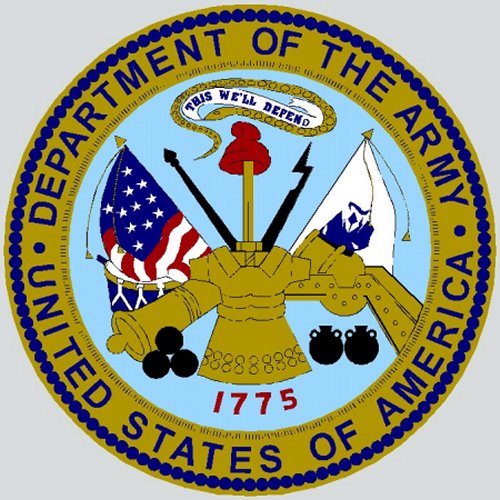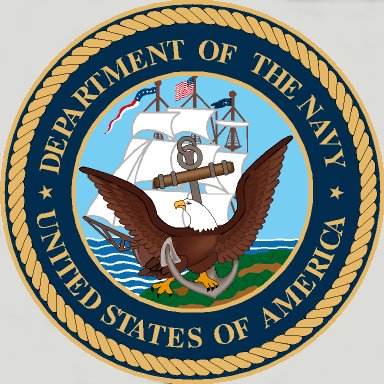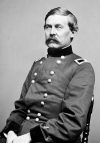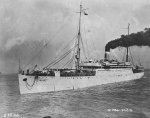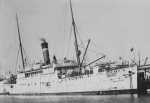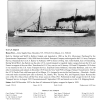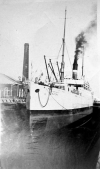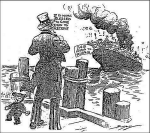This cartoon celebrates the United States' deportation of 249 (or 250 according to the New York Times) political radicals to Russia. Among those on the passenger list of the USAT Buford were the anarchists Emma Goldman and Alexander BerkmanBuford's most notorious incarnation was when she was pressed into service as the "Soviet Ark" (or "Red Ark"). On December 21, 1919, she was used to deport 249 political radicals and other "undesirable" aliens, mostly members of the Union of Russian Workers, to the Russian SFSR. Also swept up were the fiery anarchists Emma Goldman and Alexander Berkman. This occurred between the first and second Palmer Raids of the first "Red Scare" period in the U.S. After delivering her charges, the Buford returned to New York on February 22, 1920.
During the First Red Scare in 1919-20 following the Russian Revolution, anti-Bolshevik sentiment quickly replaced the anti-German sentiment of the World War I years. Many politicians and government officials, along with a large part of the press and the public, feared an imminent attempt to overthrow the government of the United States and the creation of a new regime modeled on that of the Soviets. In that atmosphere of public hysteria, radical views as well as moderate dissents were often characterized as un-American or subversive, including the advocacy of labor rights and any less than complementary discussion of American society and its system of government. Close ties between recent European immigrants and radical political ideas and organizations fed those anxieties as well.
The Espionage Act of 1917 made it a crime to interfere with the operation or success of the armed forces of the United States. It effectively criminalized any act or speech that discouraged full compliance with the military draft. Convicted under this law, Eugene V. Debs, a five-time presidential candidate, served 3 years of a 10-year sentence before President Warren G. Harding commuted his sentence on Christmas Day, 1921. Emma Goldman and Alexander Berkman were likewise convicted under the Espionage Act and eventually deported. The Immigration Act of 1918 denied entry into the U.S. and permitted the deportation of non-citizens "who disbelieve in or are opposed to all organized government."
Leading Personages on the Buford's Passenger-List were Emma Goldman, Ethel Bernstein, Peter Bianki, Alexander Berkman.
The Buford steamed out of New York harbor at 6 A. M. on Sunday, December 21, 1919, with 249 "undesirables" on board. Of those, 199 had been seized in the November 7 Palmer Raids. Some were leftists or anarchists, though perhaps as many as 180 were deported because of their membership in the Union of Russian Workers, an anarchist organization which served social and educational functions for many Russian immigrants, had been the principal target of the raids. Other deportees, including the well-known radical leaders Emma Goldman and Alexander Berkman, had been detained earlier. All, by act or speech or membership in an organization, fell within the legal definition of anarchist under the Immigration Act of 1918, which did not distinguish between "malignant conspirators and destructive revolutionists" on the one hand or "apostles of peace, preachers of the principle of non-resistance" on the other. All met the law's requirement in that they "believed that no government would be better for human society than any kind of government." Goldman had been convicted in 1893 of "inciting to riot" and in 1917 for interfering with military recruitment. She had been arrested on many other occasions. Berkman had served 14 years in prison for the attempted assassination of industrialist Henry Clay Frick after the Homestead Steel Strike in 1892. In 1917 he had been convicted alongside Goldman for the same anti-draft activities. The notoriety of Goldman and Berkman as convicted agitators allowed the press and public to imagine that all the deportees had similar backgrounds. The New York Times called them all "Russian Reds."
Not all the deportees were unhappy to be leaving the United States. Most were single, few were being separated from their families, and some anticipated a brighter future in the new Soviet Russia.
Twenty-four hours after its departure, the Buford's captain opened sealed orders to learn his projected destination. The captain only learned his final destination while in Kiel harbor while awaiting repairs and taking on a German pilot to guide the ship through the North Sea minefields, uncleared despite Germany's surrender a year earlier. The State Department had found it difficult to make arrangements to land in Latvia as originally planned. Though finally chosen, Finland was not an obvious choice, since Finland and Russia were then at war.
F.W. Berkshire, Supervising Inspector of Immigration, made the journey to oversee the enterprise and, in contrast to his two most famous charges, reported little conflict. A "strong detachment of marines" numbering 58 enlisted men and four officers also made the journey and pistols had been distributed to the crew.
In "My Disillusionment in Russia," Emma Goldman wrote of the Buford voyage:
For twenty-eight days we were prisoners. Sentries at our cabin doors day and night, sentries on deck during the hour we were daily permitted to breathe the fresh air. Our men comrades were cooped up in dark, damp quarters, wretchedly fed, all of us in complete ignorance of the direction we were to take.
Alexander Berkman, in "The Russian Tragedy," added,
We were prisoners, treated with military severity, and the Buford a leaky old tub repeatedly endangering our lives during the month's Odyssey... Long, long was the voyage, shameful the conditions we were forced to endure: crowded below deck, living in constant wetness and foul air, fed on the poorest rations.
On the evening of 9 January 1920, she arrived at Kiel and was docked for repairs. “It was not known how long the vessel will remain there, but her ultimate destination was reported to be either Libau or Riga.”
The Buford reached Hanko, Finland at 4:25 pm on Friday, January 16, 1920. The prisoners were kept between decks until they were landed the next day, Saturday, January 17, 1920, at 2 pm. They were taken off the transport and marched between a cordon of American marines and Finnish White Guards to a special train that was to take them to Terijoki, Finland, about two miles from the frontier. The 249 "undesirable aliens" were placed, 30 to a car, in [unheated] box cars fitted up with plank benches, tables and beds. Each car contained seven boxes of army rations. The supplies include bully-beef, sugar and hard bread.
Finnish White Guards were stationed on each car platform. The party was to be completely isolated until it reached its destination. Once loaded, the train was then held overnight while rumors of the party being killed as they crossed the border caused a diplomatic flurry.
The journey began the next day, January 18, but the exiles were sidetracked at Viborg, Finland, remaining confined in their cars, while awaiting the British Prisoners' Relief Mission, which was to cross the Russian frontier at the same time. Delayed by storms, the Buford began her return voyage that same day.
On January 19, the trek continued to Terijoki. Once the deportees had arrived, and after trudging through a heavy snowstorm, a parlay was conducted under white flags of truce between Berkman, guarded by the Finns, and the Russians, out on the ice of the frozen Systerbak River, which separated the Finnish and Bolshevist lines. Things being settled, the "undesirables" then crossed over into Russia at 2 pm, Berkman and Goldman waiting until everyone else had safely crossed. All were enthusiastically received with cheers and a band playing the Russian national anthem. In the war-wrecked town of Bielo-Ostrov, which overlooked the stream, they boarded a waiting train which took them to Petrograd.
Most of the press approved enthusiastically of the Buford experiment. The Cleveland Plain Dealer wrote: "It is hoped and expected that other vessels, larger, more commodious, carrying similar cargoes, will follow in her wake."
